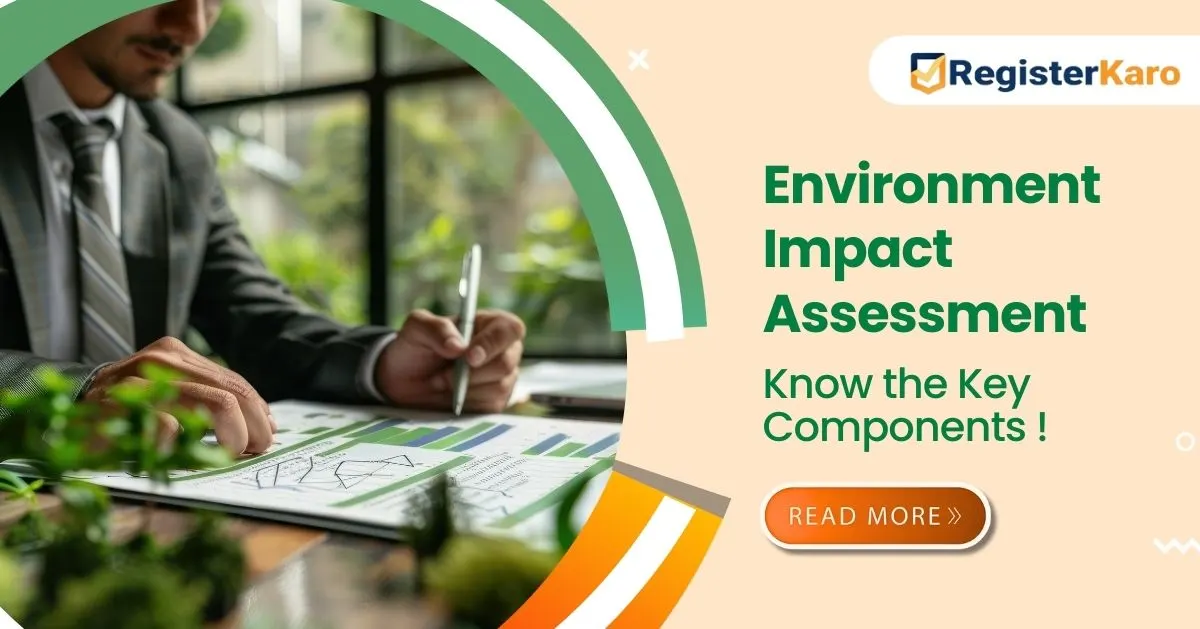
How to Write an Environmental Impact Assessment Report
Introduction
Writing an EIA report is a critical task for ensuring that your project complies with environmental regulations and successfully obtains environmental clearance. The Environmental Impact Assessment (EIA) process helps identify and mitigate the potential environmental impacts of a project before it begins.
This article will guide you through the process of writing a comprehensive EIA report, the key elements to include, and how EIA reports assist in obtaining environmental clearance in line with Indian law.
By understanding how to write an effective EIA report, you can ensure your project adheres to environmental laws and avoids delays in the approval process and RegisterKaro is here to help you for this service.
Why is Writing an EIA Report Important?
The importance of writing an EIA report cannot be overstated. The EIA report is a foundational document that provides an analysis of the environmental impacts of a project. It plays a crucial role in:
- Ensuring compliance: It ensures that your project adheres to Indian environmental regulations and guidelines.
- Preventing environmental harm: Through thorough impact assessment, it helps identify potential environmental risks and propose mitigation strategies.
- Obtaining environmental clearance: A well-prepared EIA report is a key requirement for environmental clearance from regulatory bodies.
- Engaging stakeholders: The EIA report fosters transparency by involving public consultation and ensuring that local communities’ concerns are addressed.
Ultimately, the EIA report facilitates sustainable development by providing a framework for environmentally responsible project planning and implementation.

What Are the Key Elements of an EIA Report?
An EIA report must include several key elements to meet regulatory standards and effectively communicate environmental impacts and mitigation strategies. The essential components include:
3.1 Executive Summary
The executive summary provides a concise overview of the EIA report, summarizing the environmental impacts, the proposed mitigation measures, and the overall findings of the assessment.
3.2 Introduction and Project Description
This section includes the background of the project, its objectives, and a detailed description of the project’s scope, including the location, design, and construction activities.
3.3 Environmental Baseline Assessment
The baseline assessment analyzes the current environmental conditions of the project area, including air quality, water resources, soil conditions, biodiversity, and socio-economic factors.
3.4 Impact Assessment and Mitigation Measures
This section evaluates the potential environmental impacts of the project across various parameters such as air, water, land, biodiversity, and social factors. It also outlines the mitigation measures to minimize negative impacts.
3.5 Environmental Management Plan (EMP)
The EMP outlines the strategies for implementing the mitigation measures and ensuring environmental protection throughout the project lifecycle. This includes monitoring mechanisms and responsibilities for compliance.
3.6 Public Consultation and Stakeholder Input
This section presents the feedback received during the public consultation process and addresses the concerns raised by local communities, stakeholders, and environmental groups.
3.7 Conclusion and Recommendations
The conclusion provides a summary of the findings and outlines any recommendations for minimizing environmental impacts. It also suggests the next steps for the project’s development.
How Does an EIA Report Help in Environmental Clearance?
The EIA report is crucial for obtaining environmental clearance for your project. It provides decision-makers with detailed information about the environmental impacts of the proposed project and the proposed mitigation strategies. Here’s how an EIA report helps in environmental clearance:
- Facilitates decision-making: The EIA report gives regulatory authorities all the necessary information to assess the environmental risks and decide whether the project should proceed.
- Demonstrates compliance: A comprehensive EIA report ensures that the project adheres to all Indian environmental laws and regulations, increasing the likelihood of approval.
- Engages stakeholders: By including feedback from public consultations and addressing stakeholders’ concerns, the EIA report strengthens the project’s legitimacy and ensures smoother regulatory approval.
- Outlines mitigation measures: The report includes strategies for mitigating potential environmental harm, ensuring that environmental protection is integrated into the project’s design and implementation.
Thus, a well-written EIA report is a key document that plays a pivotal role in securing environmental clearance.
Understanding Environmental Impact Assessment (EIA)
1. What is an Environmental Impact Assessment?
An Environmental Impact Assessment (EIA) is a process used to assess the potential environmental effects of a proposed project or development.
EIA identifies possible adverse impacts on the environment and suggests mitigation strategies to prevent or reduce damage. The primary goal of EIA is to ensure that projects are planned and executed in an environmentally sustainable manner.
2. Importance of EIA in Project Planning and Approval
The EIA process ensures that the environmental implications of a project are fully understood before it is approved. By identifying potential environmental impacts early on, EIA allows developers to mitigate risks, reduce project delays, and improve the overall sustainability of the project.
Steps to Writing an EIA Report
Writing an effective EIA report requires a structured approach. Here are the essential steps involved in writing an EIA report:
Step 1 Identifying Project Scope and Objectives
Clearly define the project’s objectives and scope, including its location, activities, and potential environmental impacts. This step helps set the parameters for the EIA report.
Step 2 Gathering Baseline Environmental Data
Collect data on the existing environmental conditions of the project area. This includes information on air quality, water availability, soil conditions, biodiversity, and social factors.
Step 3 Assessing Potential Environmental Impacts
Evaluate the potential environmental risks and impacts the project may cause. This includes direct, indirect, and cumulative impacts across environmental, social, and economic factors.
Step 4 Developing Mitigation Strategies
Propose measures to mitigate or prevent negative environmental impacts. These strategies should be practical, feasible, and effective in reducing environmental harm.
Step 5 Conducting Public Consultation and Stakeholder Engagement
Engage with local communities and stakeholders to gather feedback on the project’s potential impacts. Address their concerns and integrate their suggestions into the EIA report.
Step 6 Drafting and Reviewing the Final EIA Report
After completing the above steps, draft the EIA report and review it to ensure all relevant information is included, and the report adheres to Indian environmental regulations.
For a faster and easy review click here – environmental clearance today and get your consultation from our Experts today. Click here to apply for the consultation.
Legal Framework and Compliance for EIA Reports in India
1. The Environment Protection Act, 1986 – The Backbone of EIA Regulations
This Act provides the foundation for EIA regulations and empowers the government to establish environmental standards for projects.
2. The EIA Notification, 2006 – Mandatory Reporting Requirements
The EIA Notification, 2006 sets out the requirements for conducting and submitting EIA reports for various types of projects in India.
3. The Air (Prevention and Control of Pollution) Act, 1981 – Air Quality Assessment in EIA
This Act mandates that EIA reports include assessments of air quality, especially for industrial and infrastructure projects that may contribute to air pollution.
4. The Water (Prevention and Control of Pollution) Act, 1974 – Ensuring Sustainable Water Use in Projects
This law ensures that EIA processes include assessments of how projects may affect water resources and proposes solutions for sustainable water management.
5. National Green Tribunal (NGT) Guidelines on EIA Compliance
The NGT provides guidelines and rulings on the compliance of EIA reports and environmental protection during the implementation of projects.
Common Challenges in Writing an EIA Report
Writing an EIA report comes with its challenges, including:
1. Lack of Accurate Environmental Data
Insufficient or inaccurate data can compromise the quality of the EIA report, leading to incomplete or inadequate impact assessments.
2. Compliance Issues with Indian Environmental Laws
Ensuring that the EIA report aligns with Indian environmental laws can be challenging, especially for complex projects.
3. Stakeholder Opposition and Public Consultation Challenges
Engaging stakeholders and addressing their concerns can be difficult, particularly in areas where local communities have strong objections to the project.
4. Delay in Environmental Clearance Due to Incomplete Reports
Incomplete or poorly written EIA reports can lead to delays in obtaining environmental clearance, which can affect project timelines.
How RegisterKaro Can Help in Writing an EIA Report?
At RegisterKaro, we offer professional EIA report writing services to ensure your project complies with Indian environmental regulations. Here’s how we can assist:
- Professional assistance in preparing a comprehensive and compliant EIA report
- Compliance support for obtaining environmental clearance
- Liaison with regulatory authorities to ensure timely approvals
- Cost-effective and reliable EIA report writing services
Conclusion
Writing an effective EIA report is essential for obtaining environmental clearance and ensuring that your project aligns with Indian environmental laws.
A well-structured EIA report helps mitigate environmental risks, addresses stakeholder concerns, and ensures sustainable development.
Contact RegisterKaro for expert EIA report writing services that will help you navigate the complexities of environmental clearance and ensure compliance with Indian regulations.




